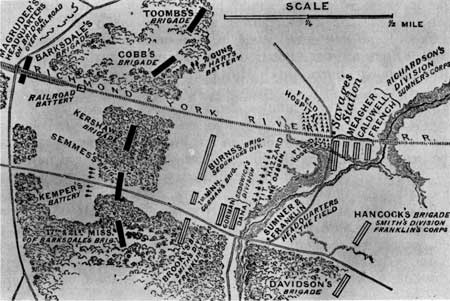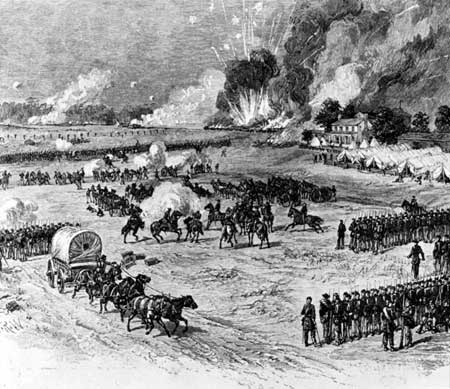|
RICHMOND National Battlefield Park |
 |
PART ONE
THE PENINSULA CAMPAIGN, SUMMER, 1862
(continued)

Battle of Savage Station.
From Battles and Leaders
of the Civil War.
Savage Station
McClellan was now engaged in the most difficult move an army can be called upon to make in the face of an aggressive enemy—a flanking movement to effect a change of base. There was no thought given to any offensive movement. President Lincoln telegraphed: "Save your army at all events." This was now McClellan's only objective.
That McClellan had not tried to fall back on White House surprised Lee, as he had believed he was facing the main part of the Federal army at Gaines' Mill. The next day, June 28, he spent burying the dead, reorganizing for another offensive movement, and attempting to divine McClellan's plans. Lee reported to Jefferson Davis that "the bridges over the Chickahominy in rear of the enemy were destroyed, and their reconstruction impracticable in the presence of his whole army and powerful batteries. We were therefore compelled to wait until his purpose should be developed." By nightfall, however, he realized that McClellan was headed for the James River, and made his plans accordingly.
Early next morning, June 29, Longstreet and A. P. Hill were to cross the Chickahominy at New Bridge and take the Darbytown road to where it met the Long Bridge road. Huger and Magruder, already on the south side of the river in front of Richmond, were ordered in pursuit of the Federal forces—Huger by Charles City road and Magruder by the Williamsburg road. In the meantime, Jackson would cross Grapevine Bridge and sweep down the south side of the river to get in McClellan's rear.

Battle of Savage Station.
From a contemporary sketch.
Again, Lee's strategy was brilliant. The Charles City road met the Long Bridge road at a place called Glendale or Frayser's Farm. Lee planned to have all his divisions converge there at about the time the middle of McClellan's long column should be passing. The impact of the expected blow would undoubtedly split the Union army, and with Jackson's corps in the rear of one half, the other half could be cut off and annihilated. Once again, however, the staff work and tactics were pitiful.
McClellan's rearguard was posted about Savage Station on the Richmond and York River Railroad, facing west. Richardson's division, of Sumner's corps, was in an open field north of the railroad tracks in back of the station. Sedgwick's division held the center in another open field south of the tracks, with its left resting on the Williamsburg road. Gen. William F. ("Baldy") Smith's division, of Franklin's corps, took position in the woods south of the Williamsburg road.
Magruder reached the vicinity of Savage Station about noon, June 29, but did not attack as he realized his four brigades were badly outnumbered. He halted and waited for Jackson, who was supposed to turn the Federal right flank along the Chickahominy and get in their rear. But Jackson "was delayed by the necessity of reconstructing Grapevine Bridge. " Magruder then mistakenly reported McClellan advancing and sent for two brigades from Huger to support him. Lee cancelled the order when he realized that what Magruder had hit was only the rearguard covering the Federal army's passage across White Oak swamp. What Lee did not realize, however, was that Jackson was not in position and would not reach Savage Station until 3 the following morning. Finally, about 5 that afternoon, Magruder attacked with his four brigades and two regiments, but it was too late with too little. The Federals withdrew hastily but safely. In their haste they were forced to leave 2,500 sick and wounded men in the field hospital at Savage Station and to abandon or destroy a vast amount of supplies and equipment.

|

|
|
Last Modified: Mon, Mar 4 2002 10:00:00 pm PDT |


